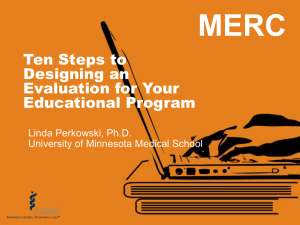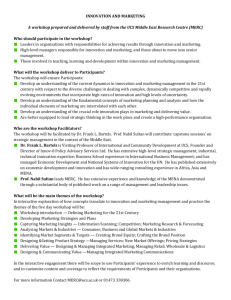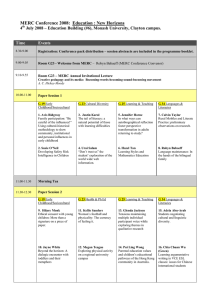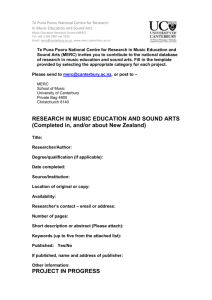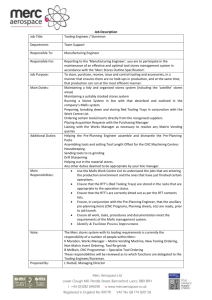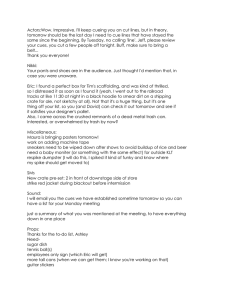Power Point: 135KB
advertisement
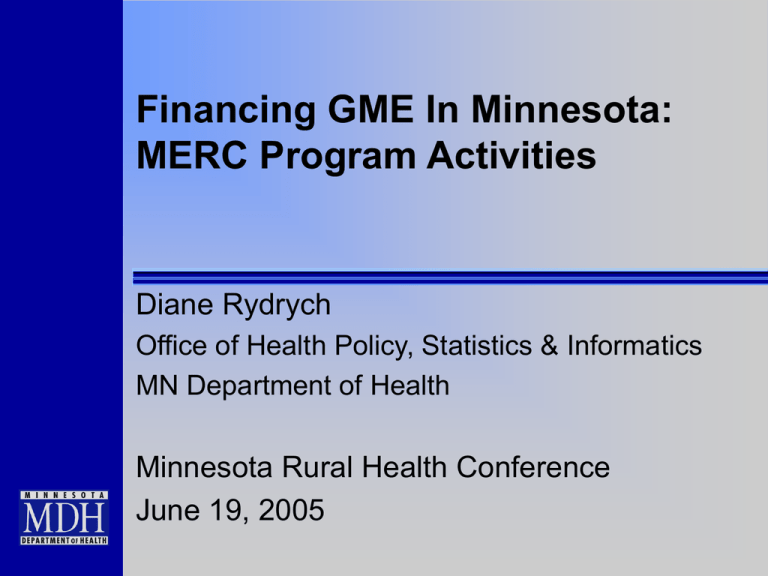
Financing GME In Minnesota: MERC Program Activities Diane Rydrych Office of Health Policy, Statistics & Informatics MN Department of Health Minnesota Rural Health Conference June 19, 2005 Overview of presentation MERC 101 – background, legislative authorization What we know about GME and training of other health professionals in MN How to apply for and use funding Special initiatives What is MERC? Medical Education and Research Costs Fund Established in 1997, funded in 1998 Focuses on funding graduate medical education, as well as education of dentists, pharmacists, advanced practice nurses, chiropractors, and physician assistants. 1993 MnCare Legislation “Subdivision 1. Purpose. The legislature finds that all health care stakeholders, as well as society at large, benefit from medical education and health care research. The legislature further finds that the cost of medical education and research should not be borne by a few hospitals or medical centers but should be fairly allocated across the health care system.” Direction to MDH: 1993 Study impact of health care reform on medical education and research financing Define scope of education/research in MN and identify need for alternative funding mechanisms Explore funding mechanisms to preserve medical education capacity Laying the Groundwork for MERC MDH worked with teaching hospitals around the state in the early 1990’s to estimate the size of the funding gap for clinical medical education – Estimated gap for 1993: $40M Governor proposed using Health Care Access Fund, funded by provider tax, to establish MERC – What is appropriate state contribution to gap? MERC Activities: Estimating the GME Revenue Gap GME Funding Gap, 1998 Revenue Costs Benefit W*Without $277,500,006 ($535,375,437) $82,867,403 ($175,008,028) 1998 MERC grants, gap would have been 10% higher ($193M) Current MERC Funding Sources Cigarette tax revenues (2.5 cents/pack) Medicaid Matching Funds $4.85M to/from AHC PMAP Carveout MERC Prepaid Medicaid (PMAP) Carveout Managed Care Organizations Premiums Carveout Medicaid Negotiated Rates, no GME MERC Medicaid FFS with GME Teaching Hospitals How is MERC funding targeted? To replace patient care revenues lost due to increased competition with non-teaching facilities To cover a portion of clinical training costs for trainees at sites in Minnesota Funds are passed from sponsoring institutions to clinical training sites Only training sites that provide care to Medicaid population are eligible MERC/PMAP Distribution Over 2,000 eligible trainees each year Formula calculates costs per trainee for each discipline, then reimburses percentage of costs – MERC/PMAP funds cover, on average, about 1520% of clinical education costs at funded sites. Since 1998, a total of ~$275M has been distributed. – Average of ~$45-$50M per year Where do MERC funds go? HCMC FUMC ST MARYS (ROCH) MAYO REGIONS ROCH METHODIST UM DDS SCHOOL ABBOTT NW NORTH MEMORIAL CHILDREN'S MPLS TOTAL FUNDS $ 42,771,481 $ 36,914,595 $ 38,256,951 $ 31,410,718 $ 21,115,957 $ 15,267,194 $ 11,450,867 $ 6,877,228 $ 4,483,200 $ 4,367,711 $ 212,915,903 % 16% 13% 14% 11% 8% 6% 4% 3% 2% 2% 77% • The majority of MERC/PMAP funding, since 1998, has gone to 10 facilities – 7 of them in the metro area Where do MERC funds go? Almost all funding (95%) since 2003 has gone to Hennepin, Ramsey, Olmsted, St. Louis, Anoka and Stearns counties. ME R C/ P MAP Blue Earth $ Kandiyohi $ Mower $ Crow Wing $ Freeborn $ Waseca $ Itasca $ Otter Tail $ Beltrami $ McLeod $ Funds re ce ive d 2003-2005 721,687 Lyon $ 179,701 389,587 Carlton $ 174,620 345,633 Steele $ 166,819 301,940 Isanti $ 165,077 300,608 Cass $ 154,273 252,083 Wabasha $ 150,728 226,310 Brown $ 143,101 214,658 Aitkin $ 123,079 208,498 Goodhue $ 120,104 190,750 Mille Lacs $ 113,748 • Rural counties have still seen large grants relative to population. How are MERC funds used? All funds are passed through to clinical training sites, which can use grants for any purpose related to clinical education. – Training sites use funds to cover incidental costs, supplies, salaries/stipends, etc. – Depending on provider type, available funds and relative costs, grant per FTE can range from $6,000 to nearly $30,000. – In 2004/2005, small training sites were ineligible for funding; they are now back in. How are MERC funds used? Starting in 2004, 10% of each institution’s grant is ‘discretionary:’ institutions can award these funds to any eligible clinical training site, using their own criteria. – Some institutions use these funds to support safety-net facilities, some to support innovative models or sites or to incent training in certain areas – In 2004, $586K to 154 rural sites Interdisciplinary/Rural Training UM: $200,000 to facilities for rural interprofessional education: – Chippewa County Montevideo Hospital • Pre-natal care – Gateway Family Health Clinic • Geriatric Care $360,000 to Walker Methodist and CUHCC (Mpls) for interdisciplinary training $150K to Hibbing dental clinic Dental Innovations Grants 18 grants to 10 organizations since 2003 – ~$3 million awarded – Recipients include MSU - Mankato, Northfield Community Action, Houston County Public Health, UM/Hibbing Dental Clinic, Apple Tree Dental, Children’s Dental Services, CUHCC – Teledentistry, mobile dentistry, outreach to underserved communities, rotations in schools/nursing homes, projects to increase interest in public health dentistry MERC Activities: Health Professional Workforce Trainee Exit Surveys – Set of 6 surveys (physician, dental student/resident, pharmacy student/resident, APN, PA, chiropractors) – 4th year of surveys (2000-2003, 2005) just finishing now – Reports including practice plans, demographics, job search experiences, factors in practice decisions available on MDH website How can I get MERC funds for my facility? Annual application process begins in August Lag time for eligibility; application collects data from 2 years earlier Work with sponsoring institution to make sure that your facility is eligible and is included as part of institution’s application Need to be currently active Medicaid provider Need to be affiliated with accredited program(s) For more information: http://www.health.state.mn.us/divs/hpsc/ hep/merc/merc.htm Diane Rydrych Minnesota Department of Health 651-282-6349 diane.rydrych@health.state.mn.us

